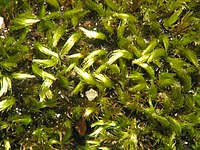Homalothecium sericeum
| Homalothecium sericeum | ||||||||||||
|---|---|---|---|---|---|---|---|---|---|---|---|---|

Homalothecium sericeum |
||||||||||||
| Systematics | ||||||||||||
|
||||||||||||
| Scientific name | ||||||||||||
| Homalothecium sericeum | ||||||||||||
| ( Hedw. ) Bruch , Schimp. & W. Gümbel |
Homalothecium sericeum , the silk moss, is a lime-loving moss. It is particularly threatened by air pollutants. Since it colonizes calcareous stone and walls, it often falls victim to human notions of cleanliness.
features
They are strong mosses that are silky, shiny and fresh green to golden or yellow-green when moist. When dry, the leaves lie on the stems like roof tiles and the branches curve upwards. The plants are then more brownish to greyish green.
The main rungs lie flat against the substrate. Side shoots then branch off more or less regularly from them. This creates quite typical narrow triangular shoots.
The leaves of the moss are narrowly triangular and long and finely pointed. They are strongly longitudinally folded along their entire length. The edge is finely sawn. The leaf vein extends into the front part of the leaf.
The capsule stands upright on a rough seta and is oblong cylindrical.
Identifying features
The plants form up to 6 cm long stems that adhere to the substrate with rhizoids. They are dense and branched fairly evenly. The branches in particular are green to yellow-green in color and have a silky sheen. They are characteristic crescent-shaped when dry, curved upwards. The lanceolate leaves with an elongated tip are longitudinally folded and densely packed. The leaf margin is relatively weakly serrated from the middle of the leaf. The leaf vein reaches about 3/4 of the leaf length. The middle lamina cells are about 50 to 100 µm long and 4 to 7 µm wide. The leaf wing cells are differentiated, hyaline and rectangular in shape. The red-brown colored sets are rough and have light brown, straight to upright, egg-shaped capsules.
Occurrence
The silk moss prefers to colonize calcareous rock and can also be found on rocks and walls. Secondarily, it colonizes base-rich bark. However, it is more likely to occur in partially shaded locations. It is widespread across Europe. Its area extends to East Asia, in the south to tropical Africa and in the west to parts of North America. It can be found in natural areas as well as in cities and is common practically everywhere in Europe .
swell
- ↑ Volkmar Wirth , Ruprecht Düll : color atlas lichen and moss. Ulmer, Stuttgart 2000, ISBN 3-8001-3517-5 .
- ↑ Jan-Peter Frahm , Wolfgang Frey : Moosflora (= UTB . 1250). 4th, revised and expanded edition. Ulmer, Stuttgart 2004, ISBN 3-8252-1250-5 .
- ↑ Martin Nebel, Georg Philippi (Ed.): Die Moose Baden-Württemberg. Volume 2: Special part, (Bryophytina II, Schistostegales to Hypnobryales). Ulmer, Stuttgart 2001, ISBN 3-8001-3530-2 .


